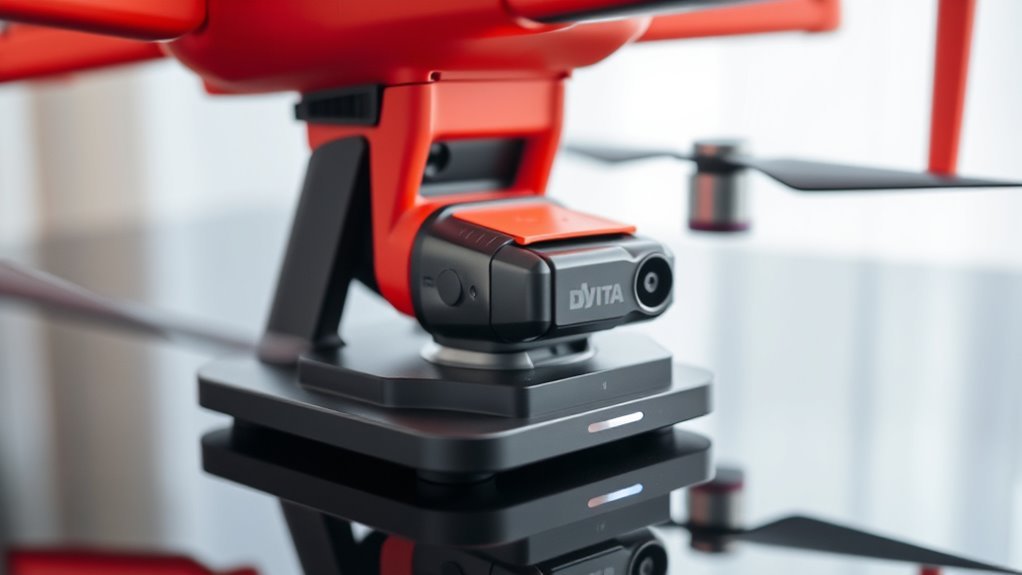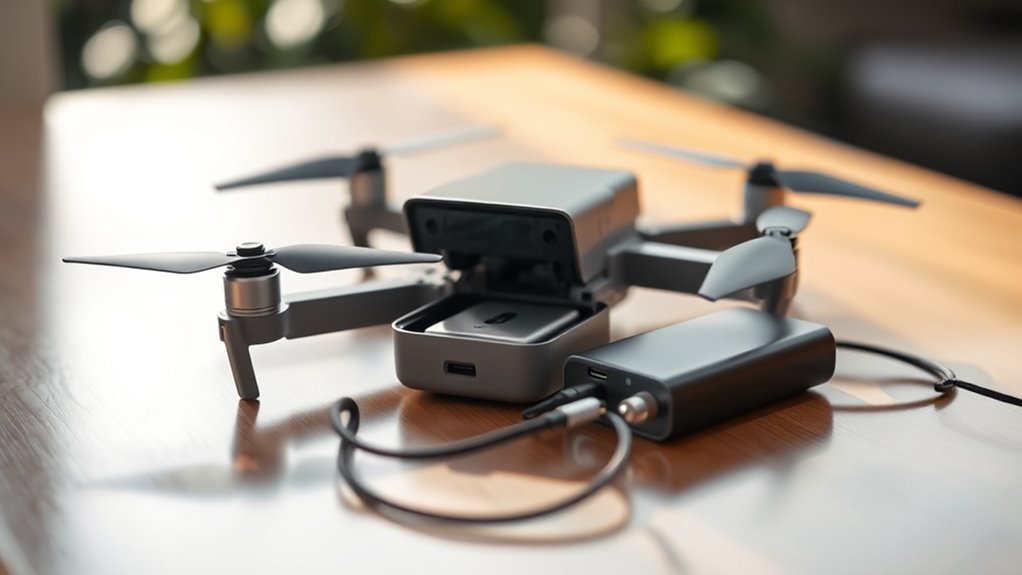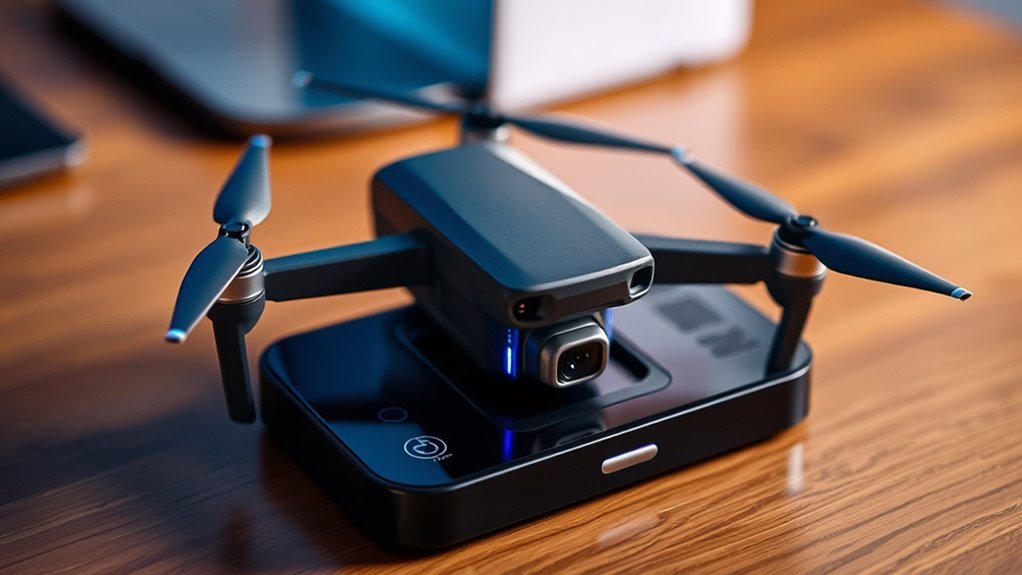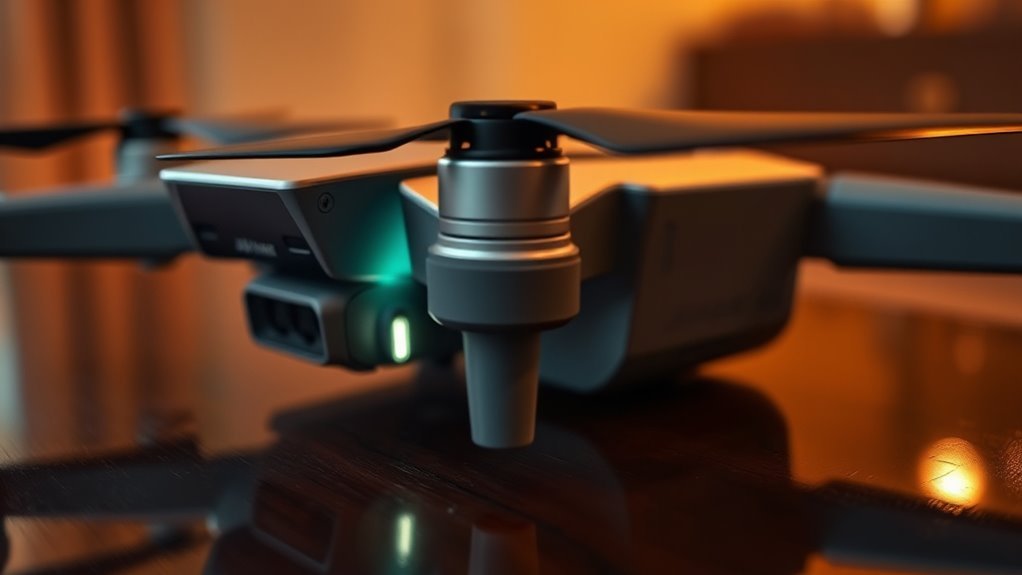To charge your DJI Avata, first inspect the battery for any damage and verify you’re using the original DJI charger for peak performance. Connect the charger to the drone and monitor the charging status through the DJI Fly app. Avoid overcharging and keep the battery in a cool and dry place. Regularly check battery health metrics to maximize flight time and efficiency. There are more tips to enhance your battery management and overall flying experience.
Understanding Your DJI Avata Battery

The DJI Avata’s battery is a vital component that powers your drone during flight, and understanding its specifications and features is essential for peak performance. This battery typically features a capacity of 2,420 mAh, providing around 18 minutes of flight time under ideal conditions. It’s important to note the charge cycles; the battery can endure approximately 500 full charge cycles before its performance starts to diminish. Each cycle represents a full discharge and recharge, so managing these cycles effectively can extend your battery’s lifespan. You’ll want to monitor the battery’s health, ensuring it maintains optimal voltage levels. Familiarizing yourself with these battery specifications not only enhances your flying experience but also grants you the freedom to explore without frequent interruptions. Additionally, understanding battery efficiency can help you maximize your drone’s performance during flights. Proper care of your battery, including charging habits, is essential for long-term durability and performance.
Preparing to Charge Your Drone

Before you plug in your DJI Avata for charging, it’s essential to confirm that both the battery and the charging equipment are in good condition. Start with battery preparation: inspect the battery for any signs of damage, such as swelling or corrosion. Verify the battery contacts are clean and free of debris, as this can affect charging efficiency. Next, check your charging setup. Make certain the charger is compatible with your DJI Avata and that the power source is stable. Using the original DJI charger is recommended for peak performance. Once you’ve verified these elements, you can proceed with charging, confirming your drone is ready for its next adventure, giving you the freedom to explore the skies confidently.
Charging Options for the DJI Avata

While there are multiple ways to charge your DJI Avata, choosing the right method can assure peak battery performance and longevity. You can use the standard DJI charging accessories, which typically include a wall charger and USB cables, to facilitate efficient charging. Alternatively, consider utilizing a power bank for on-the-go convenience or solar chargers for eco-friendly energy. These alternative power options can be especially useful when you’re outdoors and away from traditional outlets. Always prioritize using certified accessories to prevent damage to your drone’s battery. Regardless of the method, keep an eye on the charging status to avoid overcharging, which can affect battery life. Up to 27 minutes of flight time can be achieved with a full charge, so select the charging option that best fits your adventures for peak performance.
Using the DJI Avata Charging Hub
Using the DJI Avata Charging Hub can streamline your charging process, especially if you have multiple batteries. This hub is designed for seamless compatibility with DJI Avata batteries, allowing you to charge up to three batteries simultaneously. The charging indicators on the hub provide clear status updates, so you’ll know when each battery is fully charged and ready for use. Simply place your batteries into the designated slots, connect the hub to a power source, and let it do the work. Make certain to check the hub’s specifications to guarantee compatibility with your batteries, as proper fit is essential for peak performance. With the charging hub, you can keep your flights uninterrupted and your batteries ready when adventure calls.
Direct Charging With USB-C
Direct charging with USB-C offers a convenient option for powering up your DJI Avata’s batteries without the need for a separate charging hub. This method streamlines your charging process and enhances flexibility. Here are some USB-C benefits you’ll appreciate:
- Faster Charging: USB-C typically delivers quicker power transfer, reducing downtime.
- Universal Compatibility: Use the same cable for various devices, minimizing clutter.
- Compact Design: No bulky charging stations required; simply plug in your USB-C cable.
- Smart Power Management: Your drone intelligently manages power, ensuring efficiency during charging.
Embracing direct charging not only simplifies your setup but also keeps you ready for that next flight adventure without unnecessary interruptions.
Tips for Safe Charging Practices
To guarantee safe charging of your DJI Avata, always use the original charger specifically designed for your drone. It’s essential to monitor the charging environment, keeping it free from extreme temperatures and moisture. Additionally, avoid overcharging the battery to maintain its longevity and performance.
Use Original Chargers
When it comes to charging your DJI Avata, relying on the original chargers is essential for maintaining battery health and guaranteeing safe operation. Using third-party chargers can lead to compatibility issues that might damage your battery or drone. To ensure peak performance, follow these guidelines:
- Always use the official DJI charger designed for your Avata model.
- Check the voltage and current ratings on the charger to match the battery specifications.
- Inspect the charger and cables for any signs of wear or damage before use.
- Avoid using multiple chargers simultaneously, as this can lead to overheating.
Monitor Charging Environment
Although it may seem trivial, monitoring your charging environment is essential for guaranteeing the safety and longevity of your DJI Avata’s battery. Choose a suitable charging location—preferably a flat, dry surface away from direct sunlight or flammable materials. Extreme temperatures can degrade battery performance, so maintain temperature control by keeping the charging area between 20°C and 25°C (68°F and 77°F). Avoid charging in overly hot or cold environments, as this can lead to reduced capacity or even battery failure. Additionally, guarantee proper ventilation to prevent overheating during the charging process. By being mindful of these factors, you’ll not only extend your battery’s lifespan but also enhance your overall flying experience with the DJI Avata.
Avoid Overcharging Battery
While it might seem convenient to leave your DJI Avata’s battery charging overnight or for extended periods, doing so can lead to overcharging, which considerably shortens the battery’s lifespan. To maintain peak performance and longevity, consider these tips for safe charging practices:
- Set Charging Timers: Use timers to guarantee your battery isn’t overcharged.
- Monitor Charging Frequency: Avoid frequent full charges; aim for partial charging when possible.
- Charge in Intervals: Disconnect the battery after it’s fully charged; don’t leave it connected.
- Utilize Smart Chargers: Invest in chargers that automatically stop when the battery reaches full capacity.
Following these guidelines will help you maximize your DJI Avata’s battery lifespan while guaranteeing safe charging practices.
Monitoring Battery Health
Monitoring the battery health of your DJI Avata is essential to guarantee peak performance and longevity. Regularly check the battery’s status through the DJI Fly app, which provides insights into battery lifespan and remaining charge cycles. Pay attention to the battery’s voltage and temperature during use; excessive heat or low voltage can signal degradation. You should also keep an eye on the number of charge cycles the battery has undergone—typically, a lithium-polymer battery like yours will last around 200-300 cycles before significant capacity loss occurs. By maintaining awareness of these metrics, you can optimize your flying experience and assure your battery remains reliable, giving you the freedom to explore the skies without worry.
Best Practices for Battery Maintenance
To maximize the lifespan and efficiency of your DJI Avata’s battery, adhering to best practices for battery maintenance is key. Follow these guidelines to guarantee longevity and performance:
- Store at Ideal Temperature: Keep your battery in a cool, dry place, ideally between 20°C to 25°C (68°F to 77°F) to prevent damage.
- Avoid Deep Discharge: Don’t let your battery drop below 20% capacity frequently. This practice can greatly reduce battery lifespan.
- Regular Charging: Charge your battery after each use, but avoid keeping it plugged in for prolonged periods.
- Monitor Cycle Count: Keep track of charge cycles. Most batteries maintain efficiency for around 300-500 cycles.
Following these practices will help you enjoy extended flight times and maintain your battery’s health.
Frequently Asked Questions
Can I Charge the DJI Avata Battery While It’s Still in the Drone?
Yes, you can charge the DJI Avata battery while it’s still in the drone. For ideal battery maintenance, follow charging tips like avoiding extreme temperatures and not overcharging to guarantee long-lasting performance and freedom during flights.
How Long Does It Take to Fully Charge the DJI Avata Battery?
While you’re keen for flight, charging speed may seem slow. It typically takes about 60-90 minutes to fully charge the DJI Avata battery, balancing efficiency with preserving battery lifespan for your aerial adventures.
Is It Safe to Use Third-Party Chargers for the DJI Avata?
Using third-party chargers for your DJI Avata isn’t recommended due to potential safety risks and compatibility issues. Stick to manufacturer-approved chargers to guarantee safe operation and peak performance for your drone’s battery system.
What Should I Do if My Battery Won’t Charge?
If your battery won’t charge, check the charging indicators for any error signals. Engage in battery troubleshooting by inspecting connections and ensuring the charger’s functionality. Consider replacing the battery if issues persist for peak performance.
Can I Fly the Drone While It’s Charging?
You can’t fly your drone while it’s charging; it’s akin to trying to drive a car while refueling. For ideal drone safety and battery maintenance, verify it’s fully charged before takeoff to enjoy uninterrupted freedom in the skies.

